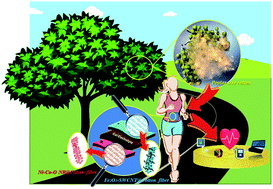Biomass-derived wearable energy storage systems based on poplar tree-cotton fibers coupled with binary nickel–cobalt nanostructures†
Abstract
We hereby demonstrate symmetric and asymmetric supercapacitors (SSCs and ASCs) based on core/shell-like Ni–Co oxide@cotton//Fe2O3–carbon nanotubes@cotton that are capable of storing a remarkable amount of energy, while retaining a high power density and long cycle life. Hierarchical, porous structures of Ni–Co–O nano-rod (NR) decorated Pd-activated cotton fibers (CFs) were fabricated using an eco-benign hydrothermal method and directly used as the cathode of the supercapacitors. Fe2O3-single-wall carbon nanotube (SWCNT) decorated CFs were employed as anodes of the fabricated ASCs. The assembled Ni–Co–O@cotton//Fe2O3-SWCNTs@cotton based ASCs possessed the benefits of a relatively high energy density of 16.3 W h kg−1 at a reasonable power density of 600 W kg−1 while showing remarkable cycling durability, retaining around 85% of their initial specific capacity after 4000 charge–discharge cycles. The capacitive performance of the fabricated Ni–Co–O@cotton//Fe2O3-SWCNTs@cotton based ASCs was preserved even if they were bent or folded. We believe that the fabricated ASCs are promising storage devices for practical applications in high-performance wearable electronics.



 Please wait while we load your content...
Please wait while we load your content...